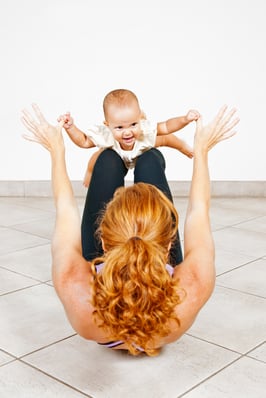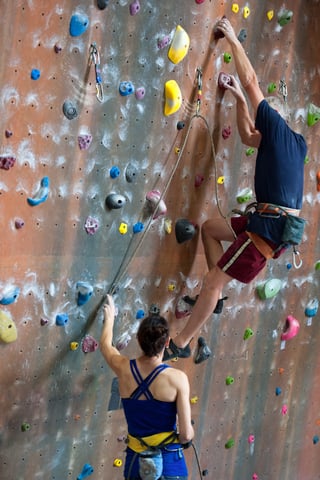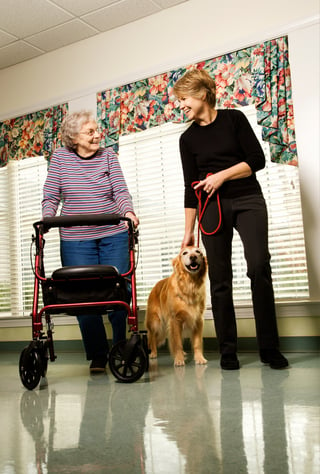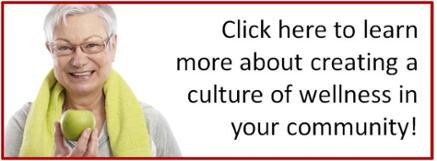.jpg?width=389&name=GettyImages-974640830%20(1).jpg) Many of us suddenly have been thrust into working from home. I am sitting on a folding chair, leaning over my keyboard, looking at my laptop screen that is sitting on a folding table. Needless to say, I am not in an ergonomically sound position. The Mayo Clinic has a great blog about how to set up your workspace perfectly. If you have a real home office with an adjustable chair and monitor, please follow their directions.
Many of us suddenly have been thrust into working from home. I am sitting on a folding chair, leaning over my keyboard, looking at my laptop screen that is sitting on a folding table. Needless to say, I am not in an ergonomically sound position. The Mayo Clinic has a great blog about how to set up your workspace perfectly. If you have a real home office with an adjustable chair and monitor, please follow their directions.
Make Your Home Office More Ergonomic
We do not live in an ideal world. After two days of working from home, my back is already sore. We need to do the obvious things to make our new “offices” more ergonomic:
- Check to make sure your feet are flat on the floor and your knees are at a comfortable 90 degrees.
- Next, check your arms. Your elbows should be near your sides and at a 90-degree angle.
- Your keyboard should be a comfortable distance away so that you are not reaching or scrunched.
These are the things you can control through office design.
Sit Correctly
Your behavior will be what saves or destroys your back moving forward. There are a few simple steps and activities you can do to keep your back healthy. The first thing you need to do is to sit up straight. That means sitting up and bringing your shoulder blades back and down. You are most likely not going to be able to sit with perfect posture all day long. When you find yourself slouching, just reset and sit tall and roll your shoulders back and down again. For some of us, it might be uncomfortable to sit with proper posture because we are habitual slouchers. That’s okay too; start by sitting with great posture at the top of every hour.
Strengthen Your Back
The next activities are meant to strengthen your back. The first of these is a plank. Proper form for a plank is where you are in looking at the floor with either your elbows or hands directly beneath your shoulders; your back should be mostly flat with your pelvis rolled like you are trying to put your tailbone into your belly button. Your legs should be straight and together with either your knees or toes touching the ground. You should plan on doing planks 2–3 times a day for at least 20 seconds.
The next activity is a Superman. This is where you lie on your stomach and lift your arms and legs off the ground a few inches. You will do this 10–20 times in a row for 1–2 sets. For best results, alternate with planks.
Stretch Your Back
The last thing you can to save your back is to stretch it. We are going to do 10 cat/cows and 10 bird dogs, both at lunchtime and when you finish up for the day. These stretches are easy to do, and you will be surprised at how much better your back will feel.
Top 3 Tips to Keep Your Back from Getting Sore While Working from Home
These tips will help you survive working from home with your back intact.
Sit Up Straight
- Practice good posture.
- Sit tall with your shoulder blades back and down.
Strengthen Your Back 2–3 Times a Day
- Do 2–3 planks for at least 20 seconds.
- Do 2 sets of 10-20 Supermans.
Stretch at Lunch and When You Finish for the Day
- Do 10 cat/cow stretches
- Do 10 bird dogs
Are you working from home? How do you incorporate a balance of sitting and moving to avoid a stiff back? Comment below.

 Before social distancing was a phrase many of us had heard of, online workouts had been gaining in popularity as a home-based fitness solution for a number of years. In fact, it was anticipated that it would
Before social distancing was a phrase many of us had heard of, online workouts had been gaining in popularity as a home-based fitness solution for a number of years. In fact, it was anticipated that it would 
.jpg?width=429&name=GettyImages-185211535%20(1).jpg) Tell me if this has ever happened to you: You are fast asleep in your warm, comfy bed. In the middle of that perfect sleep, you suddenly hear the telephone ringing. So you open your eyes, sit up, and slide your feet into your slippers. At this point, you are in a rush because you are now thinking that it could be an emergency. You take a few steps as quickly as you can to get to the phone, which happens to be all the way across the room. Suddenly, the front of your slipper nicks the carpet and you feel yourself going down and fast.
Tell me if this has ever happened to you: You are fast asleep in your warm, comfy bed. In the middle of that perfect sleep, you suddenly hear the telephone ringing. So you open your eyes, sit up, and slide your feet into your slippers. At this point, you are in a rush because you are now thinking that it could be an emergency. You take a few steps as quickly as you can to get to the phone, which happens to be all the way across the room. Suddenly, the front of your slipper nicks the carpet and you feel yourself going down and fast.
 The baby has arrived! Congratulations! You just completed the toughest thing on the face of the Earth (at least in my opinion). You so graciously shared your body for up to 40 weeks and endured all the highs and lows that come with being pregnant. Now comes the not so fun part, trying to get that baby weight off. Unfortunately, I think in today’s society there is so much pressure on moms to get back to their “post baby body” as quickly as possible. This pressure can often cause unrealistic goal setting which leads to frustration when you struggle to get back to where you were before the baby arrived.
The baby has arrived! Congratulations! You just completed the toughest thing on the face of the Earth (at least in my opinion). You so graciously shared your body for up to 40 weeks and endured all the highs and lows that come with being pregnant. Now comes the not so fun part, trying to get that baby weight off. Unfortunately, I think in today’s society there is so much pressure on moms to get back to their “post baby body” as quickly as possible. This pressure can often cause unrealistic goal setting which leads to frustration when you struggle to get back to where you were before the baby arrived. Someone recently asked me, “What is your favorite workout?” I thought about my answer for a little bit. I do like to run, and I usually run about three days a week, but is that my favorite workout? No, my favorite workout is always when I’m trying new exercises or activities!
Someone recently asked me, “What is your favorite workout?” I thought about my answer for a little bit. I do like to run, and I usually run about three days a week, but is that my favorite workout? No, my favorite workout is always when I’m trying new exercises or activities!
 Certain exercises, such as the sit-to-stand and the seated row, should always be performed in one's routine. Certain experts recommend that one would eventually replace these exercises with a new one. The reasoning behind this is that it is believed that over time the muscles will grow accustomed to certain exercises and the effect will be lost. While this is slightly true, it's not true because of the exercise itself, but rather the variables of the exercise, such as the sets, reps, rest periods, tempo, etc.
Certain exercises, such as the sit-to-stand and the seated row, should always be performed in one's routine. Certain experts recommend that one would eventually replace these exercises with a new one. The reasoning behind this is that it is believed that over time the muscles will grow accustomed to certain exercises and the effect will be lost. While this is slightly true, it's not true because of the exercise itself, but rather the variables of the exercise, such as the sets, reps, rest periods, tempo, etc.
 lunch, walking down the hallway, or picking up groceries, multiple muscles are being used through the range of motion of multiple joints. That’s why the compound, multi-joint, closed-chain movements are so much more effective than isolation, single-joint, open-chain movements.
lunch, walking down the hallway, or picking up groceries, multiple muscles are being used through the range of motion of multiple joints. That’s why the compound, multi-joint, closed-chain movements are so much more effective than isolation, single-joint, open-chain movements. 